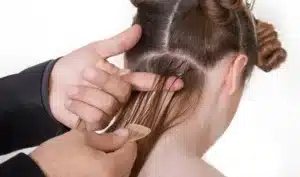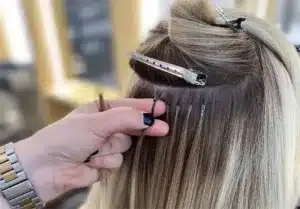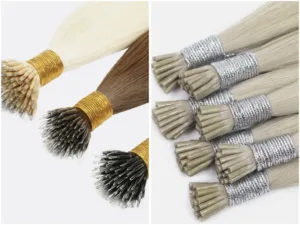Do you want length, volume, or both? Are clip-ins, tapes, or wefts confusing? Let’s build a clear plan that fits real hair and real life.
To choose the right hair extensions, match method to lifestyle, color to undertone, length to body markers, weight to density, and texture to natural pattern. Set maintenance and budget. Test with swatches. Select quality hair with consistent grams and safe construction.
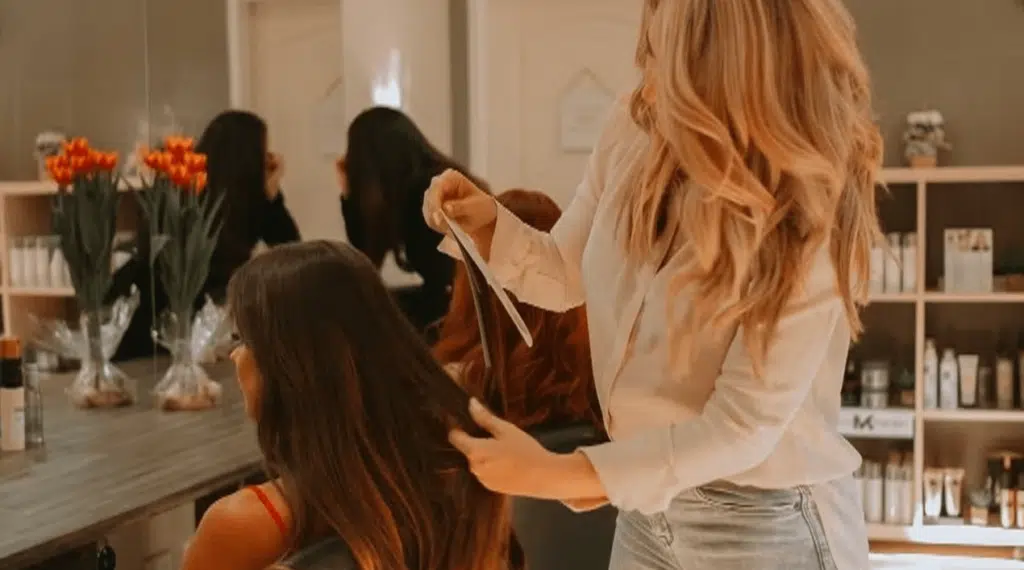
Start with the goal, then measure current hair, then pick the system. After that, refine color, length, and grams. This order avoids visible seams, protects the scalp, and saves time. The sections below work like a reusable checklist for salons, wholesalers, professionals, and consumers.
How To Choose The Right Types of Hair Extensions?
Big promises can hide trade-offs. Daily speed, weekly care, and long-term cost all change with the method chosen.
Choose a type by wear time, comfort, concealment, and maintenance. Clip-ins and halo fit quick changes. Tape-ins give flat results with medium upkeep. Hand-tied or genius wefts suit long wear. Keratin and micro-bonds allow precision mapping.
Dive deeper
Begin with end use: events, daily wear, or months of continuous wear. Clip-ins and halo pieces excel for events and photos. They go on and off fast, protect the scalp, and keep cost low across time. They require smart storage and gentle washing off the head. Tape-ins deliver a flat base and efficient installs. They need oil-free care near the PU strip, moderate heat near the base, and move-ups every 6–8 weeks. Hand-tied or genius wefts distribute weight across rows, feel light, look very flat, and can be reused through many cycles when stitched and mapped well. They require full drying at the stitch line. Keratin bonds and micro bonds (including V-light style bonds) enable the most precise mapping. They conceal well in thin zones but require longer application times and patient, chemical-first removals to avoid breakage.
Scalp sensitivity, hairline density, and lifestyle refine the choice. Athletes and swimmers benefit from fast drying and strict base care. Fine hair at the temples needs lighter grams and flatter systems. Frequent stylers need quality hair that holds curl with moderate heat. This table helps structure decisions.
| Method | Install time | Wear time per cycle | Maintenance | Best for | Notes |
|---|---|---|---|---|---|
| Clip-ins | Minutes | Day-use | Storage care | Occasional glam | No adhesive, lowest risk |
| Halo | Minutes | Day-use | Storage care | Quick volume | Very gentle on scalp |
| Tape-in | 1–2 hrs | 6–8 weeks | Move-up | Flat finish | Oil-free base required |
| Hand-tied/Genius weft | 2–3 hrs | 6–10 weeks | Row move-up | Long wear, thin hair | Dry stitch fully |
| Keratin bonds | 3–5 hrs | 8–12 weeks | Removal/rebond | Precision mapping | No scrubbing bonds |
| Micro | 3–5 hrs | 6–10 weeks | Rebond | Ultra-fine areas | Tiny bonds, patient work |
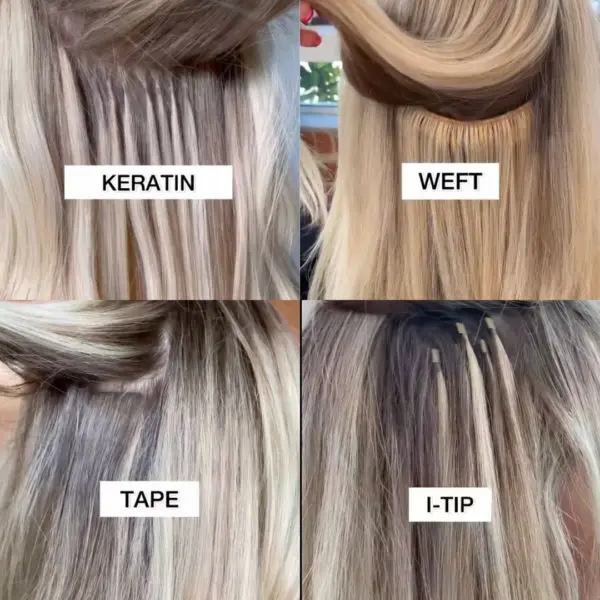
How to choose the right color hair extensions?
A good match beats a good filter. Color must blend in level, undertone, and dimension under real light.
Match level first, then undertone, then dimension. Use 2–3 swatches in natural light. Blend with lowlights or a rooted smudge when needed. Plan brass control for blondes and reds.
Dive deeper
Indoor lighting often lies. Always check color near a window and under daylight bulbs. Match the lowest two inches of natural hair for down styles; match mid-shaft for frequent ponytails. Start with level (depth scale from black to pale blonde). Place swatches under a section, not on top, to see how fibers merge. Next, confirm undertone. Cool undertones pull ash or beige. Warm undertones pull golden or copper. Neutral sits between. Multi-tonal hair benefits from a base shade plus a second shade for dimension. A subtle root smudge or shadowed top can hide seams in active parting patterns.
Plan for sun, water, and heat. Blondes can pick up chlorine cast or sunscreen staining; choose hair-safe UV sprays and avoid avobenzone on hair. For brass control, use purple or blue masks on mid-lengths to ends only, never on tapes, bonds, or stitches. Keep products light to protect cuticles and avoid slip at bases. Use the matrix to standardize decisions.
| Step | What to check | Why it matters | Simple rule |
|---|---|---|---|
| Level | Depth match | Seamless blend | Match the body of the hair |
| Undertone | Cool/neutral/warm | No color clash | Swatch in daylight |
| Dimension | Single vs blend | Natural movement | Add lowlights if flat |
| Root | Shadow or not | Hide seams | Smudge for parting styles |
How to choose the right length hair extensions?
Length is not a number alone. Length is where hair lands on the body and how it moves after styling.
Select length by body markers, height, and texture. Add 2 inches for curl shrinkage. Balance face shape with front pieces. Trim to connect natural ends to extension ends.

Dive deeper
Body markers make length visual before ordering. On many average heights, 16 inches sits at the bust, 18 inches at lower bust, 20 inches near the ribs, 22 inches at the waist, and 24 inches at the hip line. Taller people see the same lengths land higher; shorter people see them lower. Waves and curls “eat” length: a loose wave shortens about 1–2 inches; tighter curls can shorten 3–4 inches or more. Add extra inches to keep the final look where expected after styling.
Weight and length interact. A long set needs enough grams for a full hem; too few grams give a stringy baseline. Check natural thickness at the ends. Blunt, thick ends may require more grams or an extra row. Wispy ends blend with fewer grams. Keep the face frame soft by dropping guide pieces at cheek or collarbone height to connect. Heat styling shifts perceived length; tight curls reduce visible length; large curls maintain length with added body. This table offers a quick starting point.
| Height | 18″ lands | 20″ lands | 22″ lands | Add for waves |
|---|---|---|---|---|
| < 5’3″ | Lower bust | Waist | High hip | +1–2″ |
| 5’4″–5’7″ | Bust | Lower ribs | Waist | +1–2″ |
| > 5’8″ | High bust | Bust | Lower ribs | +2–3″ |
How to choose the right weight (grams) and density?
Too light looks stringy. Too heavy strains follicles. The right grams match both density and method.
Choose grams by hair thickness, length goal, and method limits. Blend with layers, not bulk. Spread weight across rows or sandwiches. Start light, then add only where coverage needs it.
Dive deeper

Estimate grams from three inputs: natural density at the ends, desired length jump, and method constraints. A 2–4 inch length jump on fine hair often needs 80–120 g for clip-ins or 120–160 g for semi-permanent installs. A 6–8 inch jump often needs 160–200 g or more. Very long looks at 22–24 inches often require 180–220 g depending on head size and cut. Avoid stacking too many tape sandwiches in one location; distribute grams to reduce pressure and increase concealment. For wefts, split weight across more than one row to lower tension and speed drying.
Protect fragile edges. Temples and widow’s peaks deserve less weight and more distance from the hairline. Crowns need careful mapping to prevent exposure with wind or ponytails. Parting patterns matter: middle parts need symmetric coverage; side parts benefit from diagonal mapping. Trim extension ends to align with the natural baseline; this refinement often reduces the grams required for a full look. Use this guide to set safe baselines.
| Natural density | Length goal | Clip-ins (guide) | Semi-permanent (guide) |
|---|---|---|---|
| Fine | +2–4″ | 80–120 g | 120–160 g |
| Medium | +4–6″ | 120–160 g | 160–200 g |
| Thick | +6–8″ | 160–220 g | 180–220 g |
How to choose the right texture and pattern?
Texture sells the illusion. When the pattern fights the natural pattern, seams show.
Match extension texture to the usual, day-to-day pattern. Choose straight, body wave, loose wave, or curly. Plan heat habits and humidity. Use light products to keep cuticles smooth.
Dive deeper
Start with a simple question: what does the hair do on a normal day without heavy styling? Air-dry straight hair blends best with straight or soft body wave textures. Hair with soft bends pairs well with loose wave. Hair that forms curls or coils requires a curl-matched pattern for the cleanest seam. Fighting the natural pattern daily consumes time and erodes cuticle health. For wavy and curly textures, prioritize products that add slip and definition without heavy oils at the base; layer a leave-in and a light gel for hold. For straight textures, keep heat moderate and use heat protectant mists.
Climate matters. In humid zones, wavy and curly textures expand. Prefer intact cuticle hair that holds pattern without high heat. In dry zones, ends can look brittle; add hydration to mid-lengths and ends only to avoid base slip. For people who switch styles often, full-cuticle hair tolerates restyling better and holds shape with lower heat. Watch for chlorine and some sunscreens staining light blondes; plan a chelating routine after travel and choose hair-safe UV products.
| Natural pattern | Best extension texture | Styling tip |
|---|---|---|
| Straight | Straight or body wave | Round brush, low heat |
| Soft wave | Body or loose wave | Cream + light gel |
| Strong wave/curly | Curly match | Diffuse low, hands-off |
| Mixed | Hybrid set | Blend with layers |

How to choose the right method for lifestyle and scalp?
A method that ignores lifestyle will fail. Work, sport, climate, and scalp health set the rules.
Pick lighter systems for fine hair and sensitive scalps. Choose fast-drying plans for swimmers and athletes. Set shorter maintenance for fast growers. Keep a gentle alternative ready during shedding seasons.
Dive deeper
Map daily life first. Frequent swimming calls for lighter maps and strict base-dry rules. A swim cap helps; a fresh-water rinse before and after the pool minimizes chlorine uptake. Daily training is compatible with extensions when the base is dried after heavy sweat. Frequent travelers benefit from clip-ins or low-maintenance wefts to reduce salon time. Sensitive scalps require lighter tension, placements away from inflamed areas, and precise, flat sectioning to keep pressure low.
Growth speed shapes cadence. Fast growers need earlier move-ups. Overdue rows create leverage and snag during brushing. Methods with quick refits or shorter cycles reduce risk. Thin hair responds well to invisible tapes, hand-tied or genius wefts, or very small bonds applied with restraint. Avoid loading fragile temples. For updo lovers, keep tracks low and flat and add extra concealment around part lines. Use this table to align lifestyle and method.
| Lifestyle/scalp | Method focus | Cadence |
|---|---|---|
| Swimmer/athlete | Light map, fast drying | 5–7 weeks |
| Frequent travel | Clip-ins or wefts | Flexible |
| Sensitive scalp | Minimal tension | Shorter check-ins |
| Thin hair | Invisible tapes or wefts | Light grams |
| Updo styles | Flat rows, hidden tapes | Careful mapping |
How to choose the right budget and maintenance plan?
Cost lives in cycles, not just day one. Low price can cost more when hair fails early.
Balance upfront spend with lifespan, reusability, and move-up fees. Select quality hair that survives many cycles. Budget for care products, heat tools, and salon time. Track grams and cycles for forecasting.
Dive deeper
Evaluate total cost of ownership. Quality full-cuticle hair commonly lasts 9–12 months or more with proper care. It styles cleaner, tangles less, and holds color better, so cost spreads across many cycles. Lower-grade hair may appear cheaper, yet it dries out fast, demands early replacement, and consumes time with detangling and re-blending. For tapes, account for move-up visits. For wefts, account for row maintenance and re-stitch checks. For keratin or micro bonds, account for removal and re-tip steps. Plan products: sulfate-free shampoo, hydrating conditioner, slip-rich leave-in, heat protectant, and a chelating shampoo for monthly resets in hard-water areas.
Protect the base and habits that protect the hair. Use moderate heat. Dry bases fully after each wash or workout. Sleep with a silk or satin pillowcase and a loose braid. Store clip-ins in satin pouches or hanger cases. Keep oils off the base and avoid heavy waxes that build up and dull movement. Track grams, shades, and install dates; reordering becomes accurate and fast. Compare paths with this quick view.

| Path | Upfront | Ongoing | Reuse | Fit |
|---|---|---|---|---|
| Clip-ins | Low–med | Minimal | High | Occasional wear |
| Tape-in | Med | Move-ups | High | Flat finish |
| Wefts | Med–high | Row maintenance | High | Long wear |
| Keratin/micro | High | Removal/rebond | Medium | Precision blend |
My opinion
Method comes first; color, length, grams, and texture follow. Light tension and clean bases protect the scalp. Maintenance cadence determines success. Plan costs by lifecycle, not day one, and measure twice before ordering. These simple rules prevent most problems and keep results natural across many wear cycles.
FAQ
How to choose the right length hair extensions for ponytails?
On average heights, 18–20 inches suits daily ponytails. Keep tracks low and flat and trim the hem for swing.
What texture blends best when styles switch between straight and curled?
Body wave blends both ways. Use heat protectant and moderate heat to prevent dryness and preserve cuticles.
How many grams make a full head?
Fine hair with a 2–4 inch jump often needs 120–160 g for semi-permanent methods. Larger jumps and longer lengths typically need 160–200 g or more.
Which method is most invisible?
On thin hair, hand-tied or genius wefts and invisible tapes look very flat. Micro bonds can disappear with careful mapping.
Do all methods require salon installs?
Tapes, wefts, and bonds require professional installs. Clip-ins and halo are DIY with simple training and proper storage.
How often is maintenance due?
Tapes: 6–8 weeks. Wefts: 6–10 weeks. Bonds: 8–12 weeks. Clip-ins: no salon maintenance, but proper storage is key.
Will sunscreen or chlorine affect color?
Yes. Some sunscreens stain blondes. Choose hair-safe UV sprays and tie hair back when applying skin SPF. Rinse after swimming.
What if two shades both look close?
Blend two harmonious shades or add lowlights for movement. Single flat colors look less natural in bright light.
Can very short hair go very long?
Yes, with more grams and careful layering. A staged plan works well: medium length now, longer later.
Is full cuticle hair worth it?
Full cuticle hair resists tangles, styles better, and lasts longer. It often lowers cost per wear across the year.
Conclusion
Choose method for lifestyle, then refine color, length, grams, and texture. Keep bases clean and tension low. Plan maintenance and budget by cycles. Swatch, measure, and match in daylight for seamless results.

